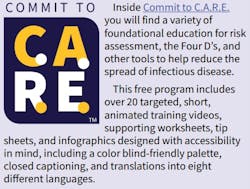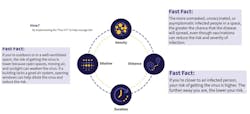The past few years have been tough on manufacturers. When the World Health Organization (WHO) declared a global pandemic in March 2020, few realized the operational changes that would be required to address the health concerns associated with COVID-19. New procedures were mandated in scheduling, social distancing, use of sanitation and respiratory protection.
To better support workers and their communities, the American Industrial Hygiene Association (AIHA) produced guidelines as part of the Back to Work Safely guidance. Now available in the Commit2CARE eBook (available for download here: https://commit2care.org/resources-aiha/), these guidelines continue to be relevant as the virus mutates and other viruses, such as avian flu, circulate.
Manufacturers need to maintain their vigilance and be prepared to apply lessons learned from the recent pandemic in the future.
The Commit2Care eBook offers a concise overview of the guidelines, with a specific section related to manufacturing and warehouse operations.
The eBook includes tips and tactics for manufacturing leaders on how to deal with infectious diseases including COVID-19, respiratory syncytial virus (RSV), measles and other airborne biological agents. The four Ds of density, distance, duration and dilution serve as the primary methodology to help reduce risk in the workplace.
The manufacturing and warehouse guidance focuses on:
1. Ventilation
2. Physical distancing
3. Masking
4. Workplace policies
5. Training and communications
Here is a sampling of the eBook’s tips in each of these areas. Also, check out the AIHA’s risk assessment tool.
1. Ventilation
Assess your heating, ventilation and cooling (HVAC) system. You can find HVAC professionals certified by the American Society of Heating, Refrigerating and Air Conditioning Engineers (ASHRAE) on their website. Occupational and environmental health and safety (OEHS) professionals and industrial hygienists can also help you navigate the complicated world of HVAC and building ventilation. You can find a list of qualified OEHS professionals on AIHA’s website: AIHA Consultants.
2. Physical distancing
Review the current production-line setup to minimize employees’ prolonged close contact with coworkers. Reduce the occupancy limit for breakrooms and other areas where people spend long periods.
3. Masking
Consider masking or advising workers to mask, especially when:
- There are high levels of infectious disease transmission in the community.
- Individuals are personally vulnerable or interact with vulnerable populations.
- You or someone in your organization has been recently exposed to the threat.
- Utilizing mass transportation.
4. Workplace policies
You can design policies specific to your workforce and workplace by focusing on two of the 4 D’s, duration and density, that reduce the risk of having too many people indoors for long periods. The possibilities include:
- Exploring staggered work shifts or hours and other flexible approaches for workers.
- Providing flexible and paid sick leave to help ensure that workers are encouraged to stay home if they have symptoms or if someone in their family is symptomatic.
- Preparing for worker absences by developing plans for alternative coverage.
- Monitoring and tracking employee absences related to infectious diseases.
5. Training and communications
Workforce instructional and communication programs can help workers understand the steps your organization is taking to keep them safe and healthy. This understanding will help them better self-advocate and identify personal ways to help reduce the risk of spreading infectious diseases.
Weekly and monthly updates help both front-line leaders and regular and part-time workers understand what your organization is trying to achieve. The famous quote from George Bernard Shaw comes to mind: “The single biggest problem in communication is the illusion that it has taken place.”
While today, geopolitical, operational and liquidity risk are at the forefront of many industry leaders’ concerns, it is essential that manufacturing and warehouse operations keep in mind the lessons learned from the most recent pandemic and remain vigilant and prepared for the next infectious disease challenge that lies ahead.







